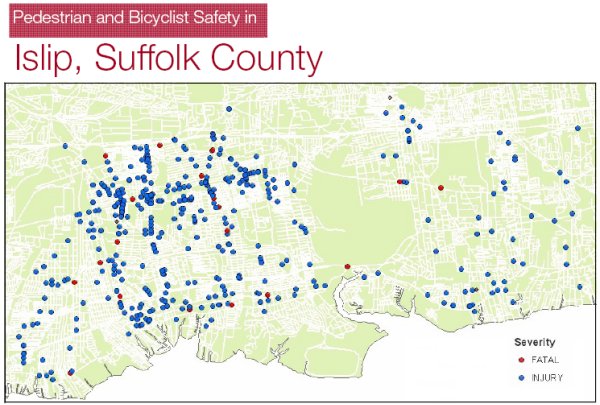
Last week, the Town of Islip in Suffolk County became the second municipality on Long Island to adopt a complete streets policy. The policy’s enactment, which came only weeks after the Town of Babylon passed its own policy, was spearheaded in a bipartisan effort by Supervisor Phil Nolan and Councilman Steve Flotteron.
“I am very pleased that our Town has taken the proper steps to implement Complete Streets throughout our communities in the future,” Supervisor Nolan told MTR. “Outdated roadways have become increasingly dangerous and it is important that when constructing a road, pedestrians and bicyclists are taken into account.”
The resolution will “establish and adopt a sustainable Complete Streets policy whereby all street projects… by the Town of Islip shall be designed and executed in a balanced, responsible and equitable way to accommodate and encourage travel by bicyclists, public transportation vehicles and their passengers, and pedestrians of all ages and abilities.” Just over fifty percent of pedestrian and cyclists injuries and fatalities in Islip occurred along town-owned roads between 2006 and 2008.

According to Councilman Flotteron, Islip’s complete streets effort aims to address this safety issue and to promote connectivity in and around the Town. “We want our town roads to be safe enough so that our residents can leave their car at home and walk or bicycle to our great downtowns,” he said. “Completing our streets allows us to do this while also enhancing our smart growth efforts and providing safe transportation choices for our constituents.”
While it’s heartening to see another municipality step up to address the epidemic of pedestrian and cyclist fatalities on Long Island’s roads, without the more comprehensive bill still sitting in the State Assembly, Islip residents will still be subject to unsafe conditions on county and state roads — including Sunrise Highway, the second most dangerous road in the region for pedestrians. Hopefully the Assembly hears the message from local towns and municipalities.
Images: TSTC.

Ryan,are there any examples that you know of (a case study or what have you) in which a community had a given set of practices for street design, passed a Complete Streets law, and then actually changed the way that they conduct street design? I ask because the Town of Islip resolution does not require that the Town adhere to a set of concrete guidelines (like MUTCD, AASHTO) but rather uses somewhat vague language – “balanced, responsible, and equitable” are relative and fuzzy terms, of course.
James,
Many communities have changed their on-the-ground designs in response to a Complete Streets policy.
The National Complete Streets Coalition generally does not recommend a policy include very specific design guidance. The conversation then tends to focus on very specific, technical aspects and not the overarching goal, which is a reformed transportation system that provides for all users. A more general policy statement, like that in Islip’s resoluion, gives the overarching vision and goal for a community’s streets and encourages flexibility and context sensitivity in design.
If you’d like examples of on-the-ground change, you need not look far: New York City is at the forefront of innovative, flexible, balanced street design. But they’re not alone; you can find examples from Colorado Springs, CO and Columbus, OH to Sacramento, CA and Seattle, WA. I highly recommend checking out the American Planning Association report “Complete Streets: Best Policy and Implementation Practices” for case studies. You can purchase it here or download a sneak peak here.
Thanks, Stefanie. I’m really familiar with what NYC is doing as far as progressive bike/ped policy and have viewed NYCDOT’s new street design manual, but I’d be interested in getting more information on smaller communities within suburban NYC that have implemented a Complete Streets law. I’ll have a look at the sneak peak of the Complete Steets case study guide you linked to. Thanks again.
[…] Islip, Long Island Adopts Complete Streets Policy (Mobilizing the Region) […]
[…] Islip Joins Babylon in Passing a Complete Streets Law; Whither Albany? (MTR) […]
[…] Islip Joins Babylon in Passing a Complete Streets Law; Whither Albany? (MTR) […]
The gist of James R’s question is whether complete streets policies have been shown to actually change the way a local government designs and uses its streets. For many years, bike master plans were in vogue, whether they made a difference is hard to say. NYC had a good bike master plan more than a decade ago. But it’s unlikely that masterplan led to the change huge expansion in bike infrastructure. More so, NYC’s efforts are not and were not driven by a complete streets policy, and the DOT’s design manual came out after numerous projects were underway. Complete streets policies are probably best seen as an additional advocacy tool and small step in changing local policy and political culture.
[…] Island municipalities have begun to embrace “complete streets” policies that commit them to designing roads for all users. The Long Island office of NYSDOT […]
[…] passing complete streets policies in: Babylon, Monmouth County, West Windsor, Red Bank, Netcong, Islip, Brookhaven, Kingston, Elizabethtown, and Hoboken. Connecticut, of course, already has a statewide […]
[…] Streets policy on Tuesday, making it the fourth policy of its kind on Long Island, behind Babylon, Islip and Brookhaven, and the first adopted policy in Nassau […]